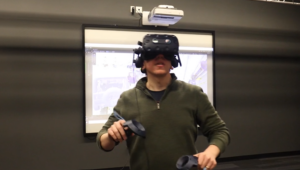
Stellantis using VR to redesign production for improved quality and reduced downtime
By onMarket Trends | Technology
Stellantis is using virtual reality (VR) technology to redesign assembly line production in an attempt to improve quality and reduce downtime.
The 40-by-42-foot VR lab is strategically located near the facility’s pilot production plant, where early builds of new vehicles are tested and validated, a news release says. It first opened in 2018 but has received continual upgrades for immersive manufacturing innovation.
Upgrades include advanced features like motion capture, physics-based part simulations, and digital twin integration, the release says. These upgrades provide real-time visualization, data accuracy, and immersive problem-solving.
“Stellantis has adapted principles from industries, such as architecture, motion pictures, and video game development, applying advanced VR technologies traditionally used for design, storytelling, and interactive environments, to optimize manufacturing processes and production quality,” the release says. “The technology is key to optimizing plant layouts, refining installation procedures, and reducing operator strain.”
VR, for example, is used for evaluating the postures and movements of hundreds of operators. The data is deployed into a digital environment that mirrors real-life assembly conditions and is used to help ergonomics teams fine-tune platform heights, set “golden zones” for an assembly operator’s reach, and refine part-handling techniques for greater safety and efficiency, according to the release.
“Manufacturing is at the heart of what we do, and advanced technologies like virtual reality allow us to continuously raise the bar,” said Tim Fallon, Stellantis North America manufacturing senior vice president, in the release. “By identifying issues before production starts, we’re making our facilities safer and better capable of delivering world-class quality to our customers.”
Stellantis has identified and resolved hundreds of potential issues on the assembly line before production begins through the use of VR, according to the release.
VR was recently used to help determine the optimal vehicle height for making underbody electrical connections at the Sterling Heights and Warren Truck assembly plants, the release said.
“By simulating multiple line heights in a virtual environment, the VR team ensured that operators would have the proper reach and access to perform these connections safely and efficiently, without ergonomic strain,” the release says. “Conducting these sessions early in the design process allowed the team to establish accurate conveyor height requirements well before installation, supporting both worker safety and production readiness.”
Additive manufacturing capabilities are included in the lab, such as 3D printing. This enables teams to create rapid prototyping and testing of components to accelerate design iterations, reduce material waste, and enhance overall production efficiency.
“As part of a global manufacturing initiative, Stellantis is scaling its VR technology across regions to improve quality, reduce downtime, and support the company’s long-term vision for smarter, more sustainable production,” the release says.
Ikarus VR released a report last year that looked at the market surge of VR applications in the automotive sector, including its use in product marketing, design, and prototyping, along with repair technician training and assistance.
The company projects that the VR market value in the automotive sector will grow to $14.7 billion by 2027.
“In the automotive sector, VR applications have diversified, with key focuses including immersive training modules for technicians, virtual showrooms enhancing customer experiences, design visualization tools aiding in prototyping and collaboration, and remote assistance platforms revolutionizing field service and support,” the report says.
VR can offer immersive training environments for technicians, which allows them to practice complex repair and maintenance tasks without physical vehicles, the report says. This can reduce costs and improve skill development.
The technology can also facilitate remote troubleshooting and guidance for technicians in the field, helping to connect them with experts to solve complex issues in real-time.
VR simulation enables testing and refining of vehicle safety features, the report says.
Volvo Cars announced earlier this year that it has synthesized incident data to create life-like virtual worlds for development. GM also announced an expanded collaboration with NVIDIA to develop next-generation vehicles, factories, and robotics using AI simulation and accelerated computing.
Last year, Porsche said it had begun working to create a framework of standards for virtual testing of vehicles as the practice is becoming more common for OEMs.
The company said it was working with Cariad, a Volkswagen software company, and the Association for Standardization of Automation and Measuring Systems (Asam e.V.) to create the standards through a project named Asam Quality Check.
Porsche Engineering created an end-to-end toolchain to generate virtual test tracks from raw data.
Data about environments is accumulated through high-resolution maps or real test drives with Porsche’s Joint User Personalized Integrated Testing and Engineering Resource (JUPITER) vehicles.
Images
Photo screenshot of Stellantis video.
